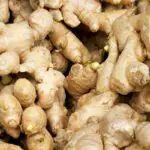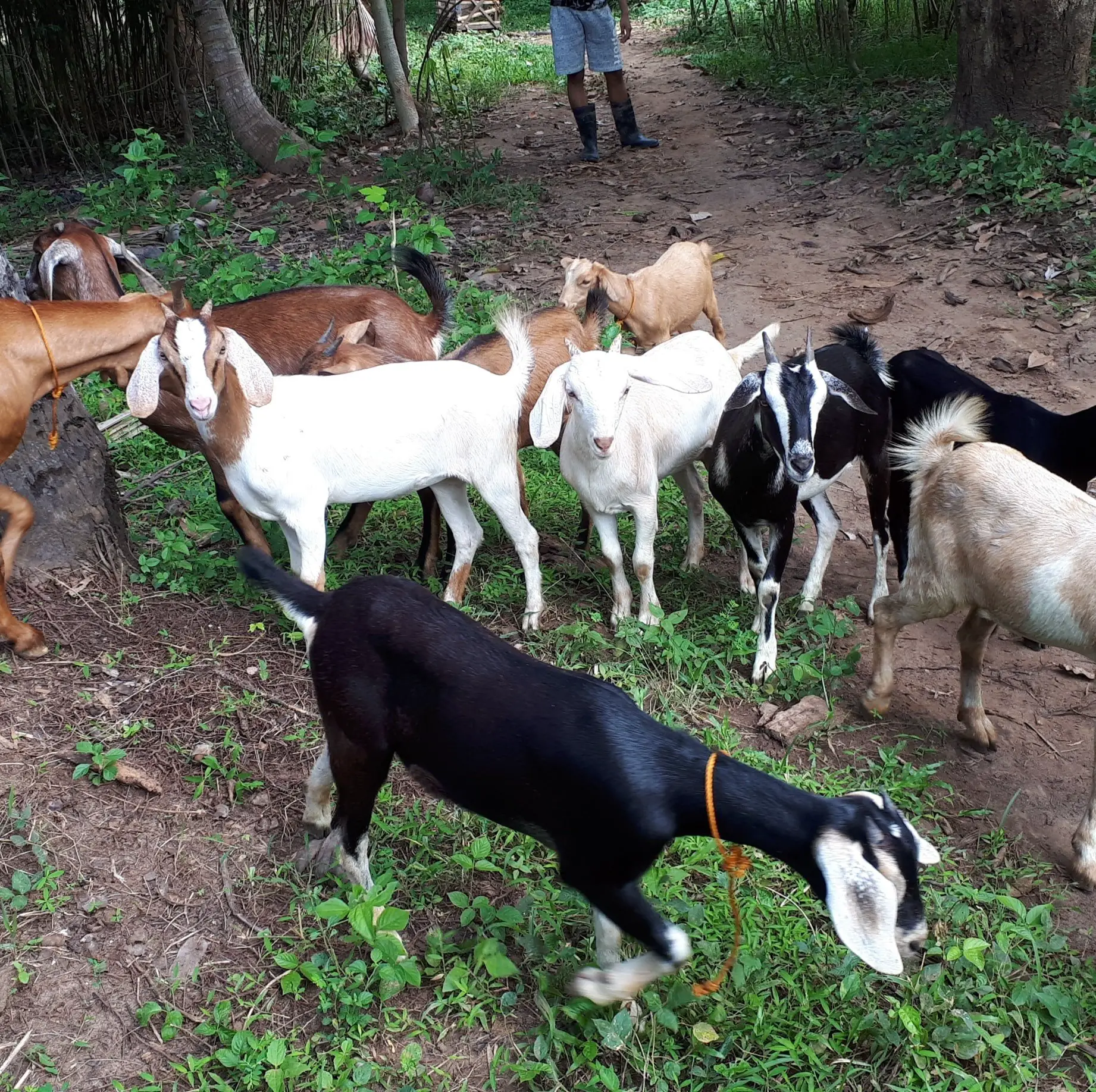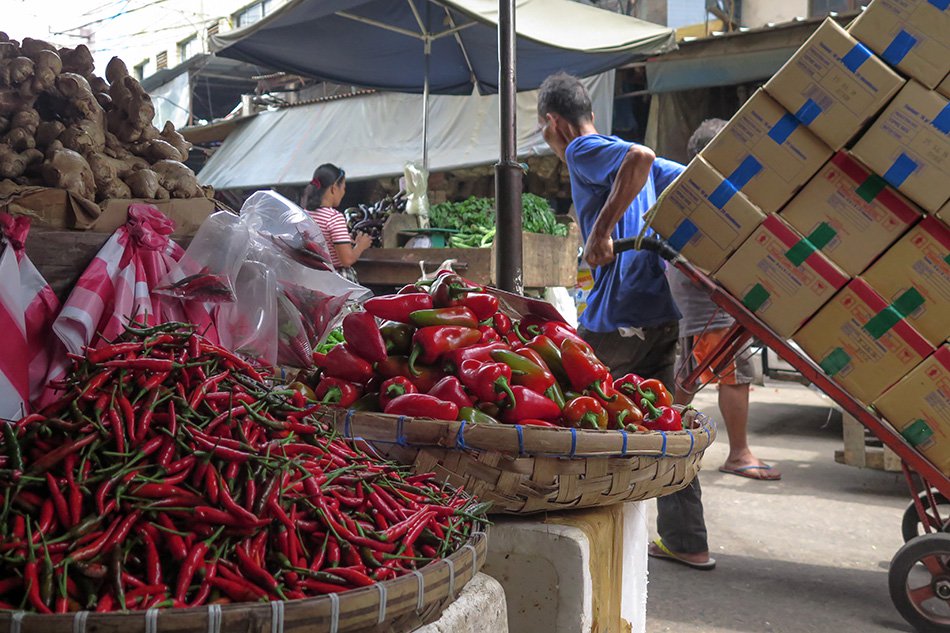Duck raising for commercial purposes is a lucrative livestock industry in the Philippines, mainly because of its egg. A duck’s most important product, its incubated egg, popularly known as balut, is a Filipino favorite that has gained international notoriety. Balut is peddled and sold daily all over the country and is famous for its tasty flavor and nutritious value.
As a result, duck production is the second-largest poultry industry in the Philippines. According to the Philippine Statistics Authority, duck egg production has increased to 13.70 thousand metric tons in the third quarter of 2022, up from 12.02 thousand metric tons in the same quarter of the previous year. It moved up at a faster rate of 13.9 percent growth annually from the 7.1 percent increase in 2021.
According to the PSA, most duck egg production (51.2% of the total in the country) comes from Central Luzon, followed by Western Visayas and Northern Mindanao.
Table of Contents
Advantages of ducks over chickens
Unsure if duck production is better than raising chicken? In this context, consider the advantages of duck over chicken.
- Ducks are stronger than chickens; they require less attention than chickens and are less likely to get sick than chickens.
- Ducks are larger than chickens, so if they are raised for their meat, there will be more to sell.
- The eggs of the ducks are also larger than the chicken eggs.
- Ducks do not necessarily need complementary grains and corn. Chickens usually need high-quality complementary food.
- Ducks eat more plant material and insects than chickens. Ducks also eat snails.
Types of ducks
1. Native ducks / Itik
The native Pateros duck commonly called itik, is the most popularly raised locally. Although smaller than the imported breed of ducks, they are good layers and non-sitters. This type of duck produces large eggs.
The itik is characterized with predominant colors black and gray. Some are barred (bulek), while others are brown or have white feathers mixed with black/green. Males have coarser heads and heavier bodies than females. Males emit shrill high pitch sounds. They have curly feathers on top of their tails.
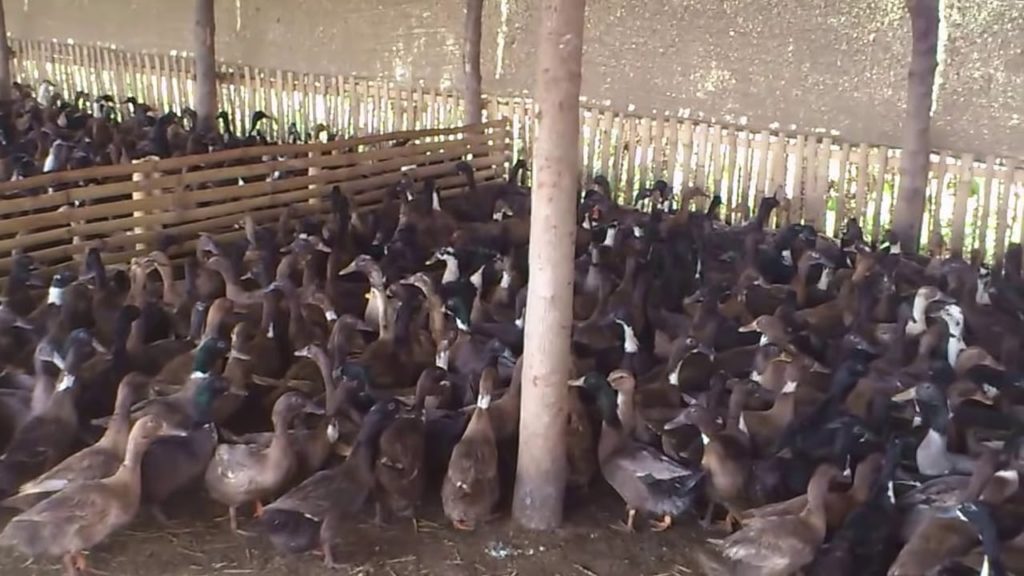
Females emit low pitch quacking sounds. Their tails feathers lie flat or close to the bodies. In all commercial ducks hatcheries, determining the sex of duckling is done at the age of 2 to 3 days.
2. Khaki Campbell duck
Khaki Campbell (Anas platyrhynchos domesticus) ducks were introduced at the turn of the century and are a cross between Mallard, Rouen, and Runner ducks. Campbell ducks were introduced in 1898 and the Khaki variety three years later. This type of duck has a characteristic brown color, has extremely active habits, does well in good range, and shows a little desire for swimming.
These ducks are good layers, they lay as many as 300 or more eggs a year which are fairly large, thick-shelled, and weigh 70 to 75 grams each.
3. Commercial Hybrid Duck
The world’s first hybrid egg-type duck was developed at Cherry Valley farms, England. It has white plumage and lays its egg at about 20 weeks of age. The body weight at the point of lay is about 1.5kg. On average this duck could lay 285 eggs up to 72 weeks of age with a mean egg weight of 75 kg. This duck can be distinguished by their pure white feathers. Their eggs are either white or greenish.
4. Indian Runner
This breed originated from the East Indies but its egg production capability was developed in western Europe.
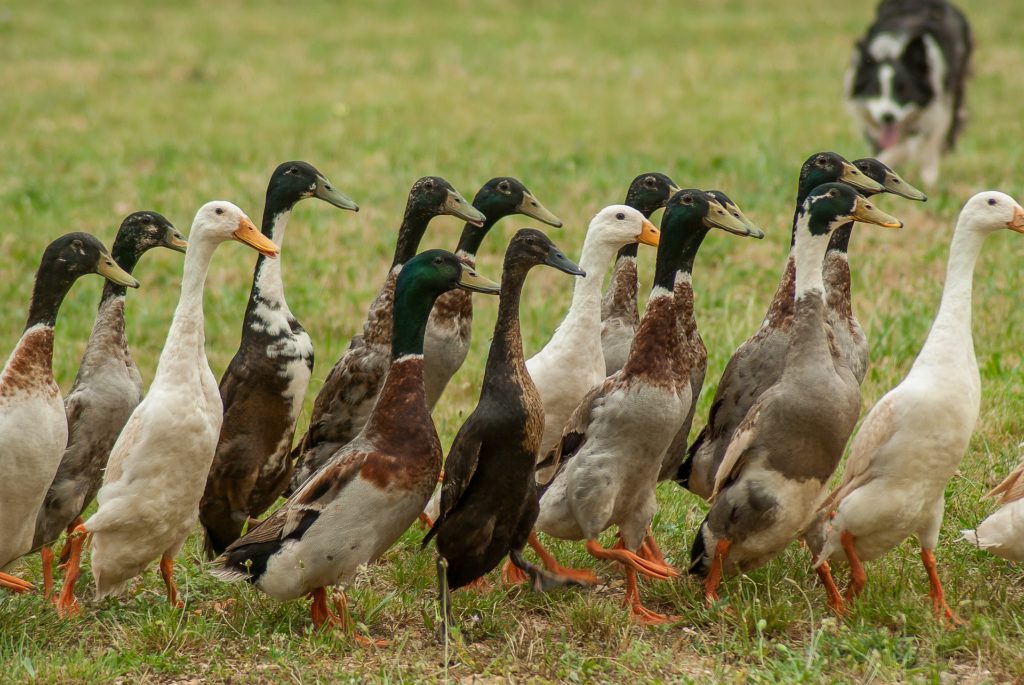
This duck assumes very erect normal postures which are almost straight neck. The back is long, straight, and narrow. An adult weighs about 2.10kg while an adult duck weighs about 1.8 kg. The egg production characteristics of this breed resemble that of the Khaki Campbell.
5. Muscovy duck / Pato
The Muscovy duck (Cairina moschata) is a large duck native to Mexico, Central, and South America. The carunculated face and red, knobby nodules above the bill’s base are distinctive features of the muscovy duck. Muscovy is a heavy breed. It has a plump body and yellow skin. It has three varieties: white, colored and blue.
Unlike other breeds, Muscovy prefers to stay on land. They are good foragers, so they require less care and can subsist on what they can pick up in the field supplemented on with palay and corn.
Muscovy has low egg production but is more self-sustaining than Pateros duck. It hatches her eggs in 33 to 35 days.
The objection to this breed is its tendency to fly far away from home and get lost. It is therefore necessary to clip their flight feathers regularly. Clip only those of one wing to remove the bird’s balance in flying.
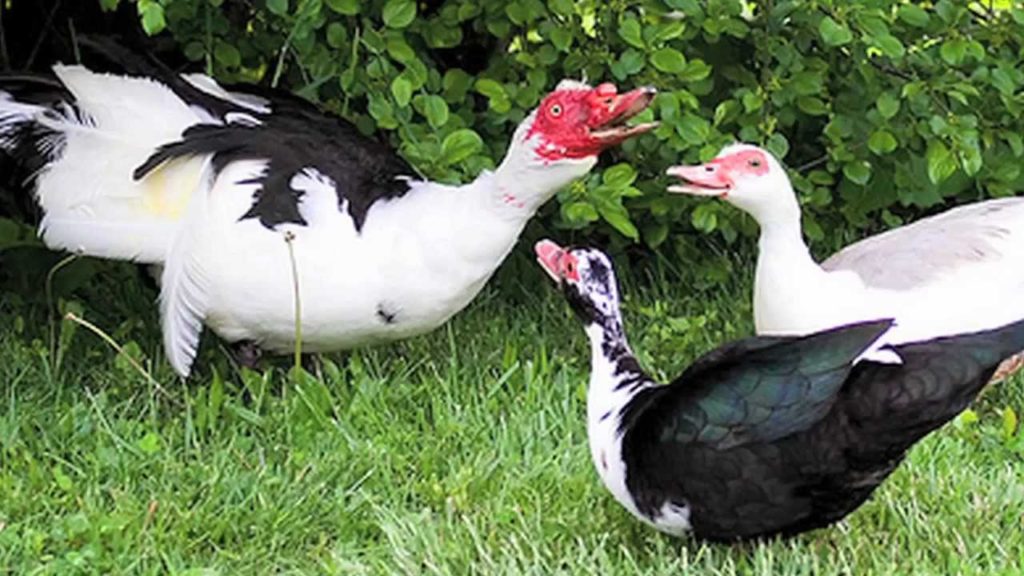
Pekin Duck
Pekin duck is native in China belonging to the meat type of ducks. Sometimes it is mistaken for a goose because it carries its body rather upright. A pekin duck is docile and well-adapted to the local Philippine climate. Pekin ducks are good layers, and ducklings is ready for market at 2 to 3 months old.
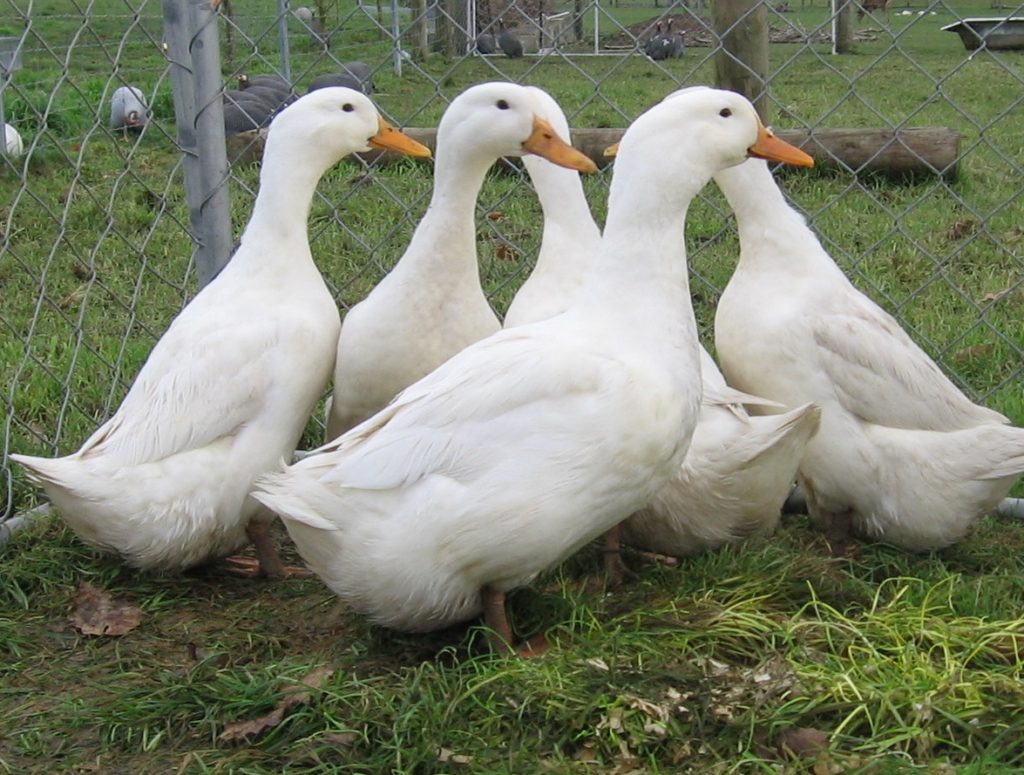
Housing your ducks
Housing ducks is not too different from other poultry products such as chicken, although it requires less attention (it is fairly independent than chicken) and care (it is less likely afflicted with diseases like chickens do).
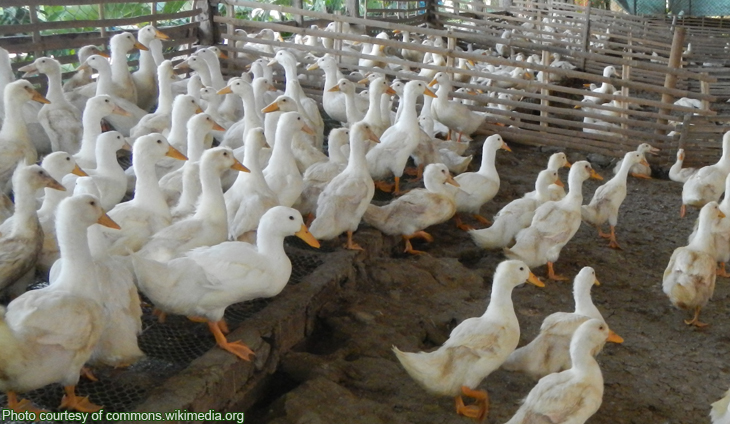
- Build your duck housing in a quiet, cool place and as close as possible to a stream or pond. Local materials like bamboo, nipa, and cogon are suitable for duck housing.
- Prepare each duck with at least 3 to 4 square feet of floor space. Cover the floor with rice hulls, corn cobs, peanut hulls, or similar materials to keep it dry and clean and help prevent the spread of pests and diseases. A house of 100 ducks measures 4 x 4 meters, or high enough to let a man stand inside.
- You may provide a swimming pond 10 ft wide and 20 ft long for 50 birds. However, the pond is not necessary for duck raising, as they lay just as many eggs without it.
- House ducks are grouped according to size or age to facilitate management and to avoid quarrels, which are common among ducks of different ages. Older ducks tend to push out younger ones from feeding troughs.
- Separate duck houses from one another by bamboo fences low enough to go over them from one pen to another. The fence should extend down to the shallow edge of the water to prevent ducks from straying too far.
Selection and mating methods
- Select vigorous breeding stock. Select breeders when birds are about 8 weeks old, and again at 4 to 5 months old before they are placed in breeding pens.
- Eggs for hatching purposes should come from ducks not less than 7 months old to ensure better fertility, hatchability, and livability of the offspring.
- Drakes (male ducks) should have the same age as ducks or even be a month older. They should be raised separately from the ducks. They are put together only when they are ready for mating.
- One drake may be mated to 6 to 10 ducks. Heavier breeds, however, should have a closer ratio of males to females than light breeds.
- Pateros ducks start laying when they are 4 to 6 months old. Muscovy and Pekin ducks start laying at 6 to 7 months old.
Hatching of eggs
The period of incubation for duck eggs is 28 days, except Muscovy, which is 30–35 days. Breeds of ducks that have a high degree of laying are non-sitters, and their eggs hatch through artificial incubation.
The Muscovy is a natural mother. She hatches and breeds her own duckling with little or no assistance from men. Native or pateros duck is a non-sitter, so her eggs are incubated under the native method of incubation called balutan.
Feeding practices
- Feed ducklings with wet starter mash for 8 weeks. Native ducklings raised the native way are fed moistened boiled rice for the first 33 weeks, 4 to 5 times a day. During the first few days, give feed at night.
- Start giving water in drinking troughs or drinking fountains on the second day. On the fifth day, add finely chopped small shrimps to boiled rice. Increase their feed as duckling grows.
- At the age of one month, feed ducklings with tiny freshwater snails and boiled unhulled rice or palay. Give only enough feed to be consumed, as they tend to spoil when left long in the troughs.
- Mash feed for ducklings is composed of corn, soybean meal, fish meal, dried whey rice bran with oyster shell, and bone meal with vitamin-mineral supplements.
- Feed one-day-old to six-week-old ducklings with starter mash with 21% crude protein; six (60) to four (4) month-old ducklings with grower mash with 16% crude protein; and four (4) month-old ducks and above with layer mash or ratio with 16% crude protein.
- If mash feed is preferred, give only enough to be consumed quickly at one time for ten (10) to 15 minutes. Wet mash tends to spoil when left in hoppers. If feed is given at intervals, ducklings learn to eat more readily, and their appetites are developed to stuff themselves in between drinks, digest food quickly, and be ready to eat their fill for the next feeding time.
- Four to five feedings a day are sufficient for ducklings over 2 weeks old. Provide plenty of clean, fresh water for ducks to drink after every mouthful of food.
- Ducks are wasteful and messy eaters during feeding sessions. Provide proper and adequate feeding hoppers to prevent much food waste.
- Fine gravel is necessary to growing ducks to help them grind their feed. After the 5th week, give green feed such as chopped leaves of kangkong camote, ipil ipil, and legumes at least three (3) times a day—10 grams of chopped green leaves per duck per day.
Maintaining health and preventing diseases
Ducks are more resistant to diseases than chickens and other fowls. Losses from various causes can be minimized through proper management, appropriate feeding and housing, strict sanitary practices, effective prevention, medication, and vaccination programs.
However, even with all precautionary measures, substantial losses are incurred in duck farming operations due to various causes. Duck diseases are those caused by pathogenic viruses, bacteria fungi, and parasites, while non-infectious types are due to chemical poisons, toxins, inferior feed or rations, and environmental factors.
Conclusion
Raising ducks in the Philippines poses a number of advantages, — inherent demand for balut, less supervision than chicken, and so on. But just like in any other fowl and poultry production, proper care and handling from hatching to feeding and housing to mating should be followed to yield desirable results.




